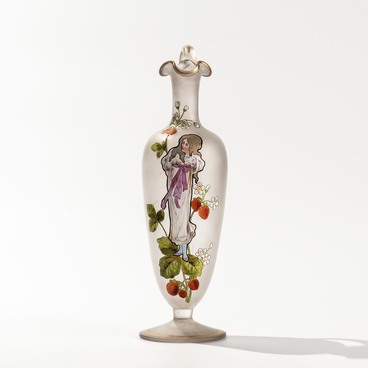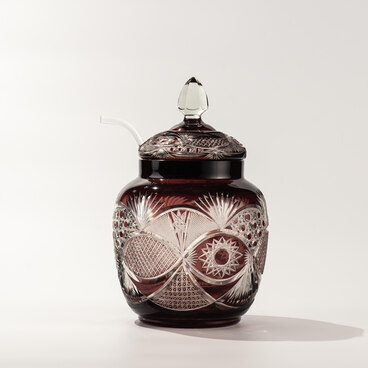For the Dyatkovo Crystal Factory, the first post-war decade was characterized not only by the need to solve technical and technological issues but also by the mass production of art glass. During that time, the factory collaborated with many Soviet glass artists. The main products of the 1950s were the ones made of two- or three-layer glass, crystal with traditional deep-cut patterns, as well as milky and colorless glass with painted images.
The pitcher from the “Snowflake” set was produced at the Dyatkovo Crystal Factory in the mid-1950s. The pitcher got its name from the winter-style design. Because its body is frosted, the pitcher looks like it is full and foggy. The fine and delicate gold painting provides additional decoration that creates the distinctive style of Dyatkovo craftsmen. The frosted surface can be achieved using various techniques, including sandblasting, acid etching, and grinding with abrasive discs. In this case, the surface was etched using hydrofluoric acid.
Gold painting is created using liquid gold that is applied to the item manually, using a brush, and then fixed on the surface during the annealing process. The fixation of the gold layer is more effective when there are copper ions on the glass surface. The content of the glass itself is of no great significance: any glass can be gilded (colored, colorless, crystal), except for the parts of items that are subject to severe wear. Sometimes gold is applied to small cavities cut in the surface. In this case, the gold painting does not wear off, and the product can remain just as beautiful for many years.
Liquid bright gold was invented by the chemist Heinrich Kuhn in Meissen, Germany, in 1830. For a long time, this method was kept secret. Later, the Duterte brothers made it public. The Dyatkovo Crystal Factory started using gold decoration in the 19th century.
Apart from the pitcher, the set includes two glasses. This convenient set is designed for everyday use.
The pitcher from the “Snowflake” set was produced at the Dyatkovo Crystal Factory in the mid-1950s. The pitcher got its name from the winter-style design. Because its body is frosted, the pitcher looks like it is full and foggy. The fine and delicate gold painting provides additional decoration that creates the distinctive style of Dyatkovo craftsmen. The frosted surface can be achieved using various techniques, including sandblasting, acid etching, and grinding with abrasive discs. In this case, the surface was etched using hydrofluoric acid.
Gold painting is created using liquid gold that is applied to the item manually, using a brush, and then fixed on the surface during the annealing process. The fixation of the gold layer is more effective when there are copper ions on the glass surface. The content of the glass itself is of no great significance: any glass can be gilded (colored, colorless, crystal), except for the parts of items that are subject to severe wear. Sometimes gold is applied to small cavities cut in the surface. In this case, the gold painting does not wear off, and the product can remain just as beautiful for many years.
Liquid bright gold was invented by the chemist Heinrich Kuhn in Meissen, Germany, in 1830. For a long time, this method was kept secret. Later, the Duterte brothers made it public. The Dyatkovo Crystal Factory started using gold decoration in the 19th century.
Apart from the pitcher, the set includes two glasses. This convenient set is designed for everyday use.



